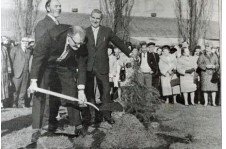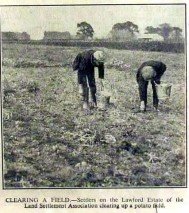
The Land Settlement Association
The Foxash LSA Story
In 2015 a heritage trail was created in Sidlesham, near Chichester in West Sussex, to commemorate the LSA which had been established in the village in 1936. A website, exhibitions and a film followed. In 2017 volunteers helped to dismantle an LSA house. It is now in storage at The Weald and Downland Living Museum, awaiting funding to be re-erected. When it is rebuilt the LSA story, including both Sidlesham and Foxash as well as the other 20 LSAs across England, will have a permanent home.
In 2019 Jo Hutchins (nee Butler Nos 23 & 63), then Denise Thomas (nee Howe No 62) created ‘Memories of Foxash Lawford’ on Facebook to keep in touch with former neighbours and friends on the LSA. Lots of people have contributed names, photos, memories, etc.
The Foxash LSA story below is a work in progress and there are lots of gaps. Can you add more pieces to the LSA jigsaw with the names, dates and stories of former tenants?
Many thanks for your help.
Dr Bill Martin (and Jo & Denise)
LSA’s
The Land Settlement Association (LSA) was a UK Government scheme set up in 1934 to re-settle unemployed workers from depressed industrial areas, particularly from North-East England and Wales.
LSAs were set up in rural areas where each successful applicant’s family would be given a small-holding of approximately 5 acres, livestock and a newly built house.
Small-holdings were grouped in communities which were expected to run agricultural production as cooperative market gardens, with materials bought and produce sold exclusively through the Association. All applicants were interviewed and given agricultural training before being assigned a property.
The allocation of smallholdings to the unemployed was suspended at the outbreak of the Second World War through the necessity of increasing food production; favour was then given to those already with horticultural skills. After the war the Association was incorporated within the 1947 Agricultural Act for statutory provision of smallholdings designed as a first step for those going into agricultural production.
The scheme was wound-up and all the properties privatised in 1983, by which time it was producing roughly 40% of English homegrown salad crops. The residual assets of the scheme were constituted as the LSA Charitable Trust, for the benefit of former tenants and to promote horticultural education
‘Here is the Land’ (1937) was shown in Dole Offices to recruit people to the LSA.
You Tube: https://www.youtube.com/watch?v=cAQwZarA58c&t=7s
From ‘The Land Settlement Association’ by K.J. McCready (1974)
Between 1934 and 1939 1,100 small-holdings were established within 21 settlements across England.
Abbotts Ann (Andover, Hampshire)
Broadwath (Cumbria/Carlisle)
Chawston (Wyboston, Bedfordshire)
Crofton (Cumbria/Carlisle)
Dalston (Cumbria/Carlisle)
Denham (Suffolk)
Elmsthorpe (Leicester)
Fen Drayton (St. Ives, Cambridgeshire)
Foxash (Colchester, Essex)
Harrowby (Lincolnshire)
Low Fulney (Lincolnshire)
Newbourn (Felixstowe, Suffolk)
Newent (Gloucester)
Oxcroft (Bolsover, Derbyshire)
Potten (Bedfordshire) 1st one Sidlesham
(W. Sussex) Snaith (Humbersde)
The Abingtons (Cambridge)
Yeldham (Essex/Suffolk)
Boverton (Glamorgan)
Stannington (Sheffield)
Foxash LSA was created from Good Hall farm house and 744 acres of land. The farm land was sub-divided into smallholdings for the LSA and some was planted as an orchard (Foxash Orchards).
(The Museum of English rural Life (MERL) at Reading University will have the original bill of sale, acreage, etc).
“These holdings are family holdings, with modern houses, averaging 5-10 acres. They are fully stocked and equipped for horticulture under glass and in the open, and for pig and poultry keeping. Applicants must have been full-time wage earners in agriculture or horticulture for at least 5 years and should have £500 to £600 to invest. The Association, which administers these holdings for the Minister of Agriculture, has facilities for arranging loans up to 75% of the total capital requirements. For application form and illustrated folder write to: The General Manager (Ref. G/1958/1) 43 Cromwell Road, London SW7” (The Grower, November 1958)"
Make it stand out.
-

Foxash LSA had 90 houses, numbered sequentially 1-90. 65 smallholdings and 25 staff houses with no land. The LSA houses were semi-detached with the exception of 19, 20, 39 and 40 which were single. There may also have been a number of tied cottages from the previous Good Hall Farm (eg Good Hall Cottages) for LSA staff who worked with shire horses, then tractor and lorry drivers or employed in the packing shed, offices, stores or the propagation unit.
-

Hunters Chase 1-6, Coggeshall Road 7-18, Home Farm Lane 19 & 20 (Staff houses) Harwich Road (Ardleigh) 21-30, Harwich Road (Lawford) 31-60, Tile Barn Lane 61-66, Hungerdown Lane 67-90.
Maps of the original plots, giving the smallholding numbers are available at (MERL) at Reading University.
Sheliagh Cheesman (No 7) has copies.
Photographed by Aerofilms in 1967.
Life on the Land Settlement
The manager of the LSA, appointed by the government, lived in Good Hall House on Coggeshall Road. The adjoining farmyard was used for storing LSA machinery.
Foxash Farm on the Harwich Road was the base for Central Services, including transport (tractors and lorries) and machinery such as the soil sterilizer. John Noy was transport manager from the 1960s until the closure, living in Foxash House.
The farm buildings behind the house were used as the LSA stores run by Bill Mathieson, where tenants could purchase tools, equipment, animal feed, fertiliser, etc. LSA machinery was also stored here.
The Packing Shed, where LSA produce was graded and packed before distribution to market, was built on land adjacent to Foxash House and run by Albert Bruce in the late 70s and 80s.
The LSA Offices, where tenants’ accounts were managed and marketing of LSA produce took place, were accommodated in the same building. In the 1940s Edward Wiseman was the LSA accountant, prior to being book-keeper at Newbourne LSA. He left in 1952 to become accountant at Sidlesham LSA.
The offices were located on the Harwich Road where Scofields Removals (CO11 2LR) is now located (2021).
The Propagation Unit (Props) was located at Home Farm (Home Farm Lane), managed by Peter Spiers during the 1960s/70s. It was dissolved at the closure and became Foxash Horticultural Services.
The Propagation Unit (Props) was located at Home Farm (Home Farm Lane), managed by Peter Spiers during the 1960 and 70’s then dissolved and became Foxash services ran by Albert Bruce and Phill Sollars and Gerrit?? . GVZ glasshouses/Double Glazing Essex (CO7 7LT) now own the site.
A Maintenance Unit, based behind the LSA stores, was responsible for repairs to houses and glasshouses with specialist plumbers, carpenters, etc. The team was led by Phil Hooper, who later moved to Spain. “The maintenance man in the 1960s and early 70s was Bill Lay Flurrie who apparently fixed most things with a large hammer and some nails!! He needed to mix a small amount of cement at ours once and used the washing up bowl from the kitchen!” (Diane King, nee Chapman No 19)
A community hut where the first tenants lived while they were being trained and their houses were being built was situated near the stores. A second ‘social club’, located in front of packhouse, was built in the mid 1970s. This building became the offices for Foxash growers in 1988/89 when the present day Foxash Social Club was constructed on the playing fields using a former office from Warners of Ipswich – it was transported to Foxash in three pieces. (Ian Cook)
Lawford CofE School 1964
Schools
Children on the LSA went to two different schools. A railway cuts the LSA estate in half with children on the Ardliegh side (Nos 1-30) attending Ardleigh St Marys CE Primary School and those on the Lawford side (Nos 31-90) going to Lawford Primary School in Wignall Street, moving site to Long Road in 1969.
A bus was available for children going to Lawford, but children walked or biked to the school in Ardleigh. At the beginning of the LSA (1936) the school leaving age was 14, rising to 15 in 1944 and then 16 in 1972. The School Attendance Register lists the names and addresses of pupils, but also details of the previous school they may have attended and hence where they lived in the north-east of England before they came to Foxash. LSA




Typical house



Clearing a field




Professor Wise
Professor Wise was appointed by the Government in 1963 to report on the LSA. His findings published in 1967, recommended that the number of LSAs be reduced to 10.
Foxash LSA continued for another 15 years, until the closure of all remaining LSAs was announced in the House of Commons on 22nd December 1982. LSAs were encouraged to continue as independent companies and tenants had the right to buy their houses and smallholdings.
Foxash Growers was established and operated until July 2012 (Company Number IP24049R) Most former LSA independent companies have now ceased trading – Snaith Salads, a subsidiary of Yorkshire Salads in still operational.
The propagation unit also became another independent company, Foxash Horticultural Services (FHS) which then produced plants for not only Foxash but also the former LSAs at Newbourne, Fen Drayton and Abington. FHS was run by two former ‘props’ employees Peter Spears and Gerritt Leppers with Albert Bruce, Phil Sollars and Dawn in the office, John Noy delivering the plants and Graham Cole making the ‘blocks’. GVZ glasshouses/Double Glazing Essex (CO7 7LT) now own the site.
Alan Marshall brought the orchards and home farm packhouse as he already had an orchard. He also employed former LSA staff and the company continued until ‘the supermarkets started to pay very little for English apples’.
In 1984, after the closure, a group of LSA tenants (cc 290) from LSAs across the country put in a claim for compensation, through their National Tenants Association, against the government. In 1991 the claim was settled in favor of the tenants.
PRESS CUTTINGS





